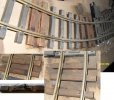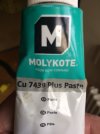You are using an out of date browser. It may not display this or other websites correctly.
You should upgrade or use an alternative browser.
You should upgrade or use an alternative browser.
Short Track Pieces
- Thread starter zman50
- Start date
Gizzy
A gentleman, a scholar, and a railway modeller....
Yes is my answer?I was wondering if anyone out there has made short track pieces out of longer track. If so, maybe you could share some tips on how to go about measuring, cutting, and installing the rail connectors. Thanks in advance for sharing your experience and technic in this project.
I use a hacksaw. You just need to measure the gap between the ends of the rail. Rail-clamps are the way to go, but I have re-used fish plate joiners. I once made a short piece of track of just one sleeper!
If you making curved pieces I'd use the same method but use a tape measure rather than a rule....
idlemarvel
Neither idle nor a marvel
There's not much of a secret to it. Remove the existing connectors, slip off the plastic sleepers and cut to size. Like in woodwork measure twice and cut once. Assuming you are cutting by hand, hold the rail in a vice, with slips of wood, plastic or rubber between the jaws as brass rail is quite soft, and cut as square as you can. Check squareness with a set square or similar and if necessary file square and remove any burrs. Cut off an appropriate run of sleepers and job done. Easier to connect small lengths with screw connectors rather than slide on ones, they take less length of rail and you don't have to fiddle with the sleepers to allow room for them. Hope this helps.
ebay mike
Retired, but still hoarding. (GOF)
I use an angle grinder - deliberately cut track too long and gently grind away the excess with the side of the disc until it fits. A piece of thick card (cereal box?) placed over the 'gap' and pressure applied to indent the track ends helps with measurements.
Like Mike, I use a carbide cut-off wheel in a battery powered angle grinder. I don't bother to remove the rails from the tie strip. I find it helps to keep the rails even for the cuts. I clean up any burrs with the cut-off wheel too. I use rail-clamps to install the cut section.
korm kormsen
Registered
Removing fishplates can be a bit of a task, there are a few You Tube Vids to show you how. This link is one of the better ones that I have found over the years.
My favoured method is to razer saw off the lip that goes down into the sleeper the. Bang off with a hammer and old screwdriver. For refitting if you re use LGB Fishplates a gentle press in to make the fit tighter at the top of the fishplate helps. But for the future I will be using the vid above one, less danger involved!
My favoured method is to razer saw off the lip that goes down into the sleeper the. Bang off with a hammer and old screwdriver. For refitting if you re use LGB Fishplates a gentle press in to make the fit tighter at the top of the fishplate helps. But for the future I will be using the vid above one, less danger involved!
JimmyB
Now retired - trains and fishing
Jon, that vid is astonishing, still amazed at the "tab" remaining in tactRemoving fishplates can be a bit of a task, there are a few You Tube Vids to show you how. This link is one of the better ones that I have found over the years.
My favoured method is to razer saw off the lip that goes down into the sleeper the. Bang off with a hammer and old screwdriver. For refitting if you re use LGB Fishplates a gentle press in to make the fit tighter at the top of the fishplate helps. But for the future I will be using the vid above one, less danger involved!
playmofire
Registered
A cunning method; one to remember.Removing fishplates can be a bit of a task, there are a few You Tube Vids to show you how. This link is one of the better ones that I have found over the years.
My favoured method is to razer saw off the lip that goes down into the sleeper the. Bang off with a hammer and old screwdriver. For refitting if you re use LGB Fishplates a gentle press in to make the fit tighter at the top of the fishplate helps. But for the future I will be using the vid above one, less danger involved!
Madman
Registered
What is more amazing is the fact that the plastic spike plate remains unharmed.Jon, that vid is astonishing, still amazed at the "tab" remaining in tact
Greg Elmassian
Guest
Yeah, looks pretty smooth, but it slides the rails in the ties, how to slide back, and of course for longer straight sections with joiners embedded, even more issues.
I just open the end of the joiner with a screwdriver, flatten it in the jaws of a pair of lineman's pliers, and twist it off in a circular motion which draws the tab from the tie.
I destroy the joiner, but leave everything else intact.
Not really tough...
Greg
I just open the end of the joiner with a screwdriver, flatten it in the jaws of a pair of lineman's pliers, and twist it off in a circular motion which draws the tab from the tie.
I destroy the joiner, but leave everything else intact.
Not really tough...
Greg
Gerard
Registered
Do not forget to add some liquified Molykote Cu 7439 Plus Paste at your rail joints.
Note: Preliquify it using petrol untill it is fluid like oil, so it creeps in all corners of the joints.
This prevents electric contact problems for many years.
It works so well since the petrol will dissolve in the air again leaving the remaining thick paste to stay on the joins.
The paste is so strong that it will not be washed away by rain.
The result is a perfect corrosion cover of the brass rail with the cupper particles making a very good electric contact.
Gerard
Note: Preliquify it using petrol untill it is fluid like oil, so it creeps in all corners of the joints.
This prevents electric contact problems for many years.
It works so well since the petrol will dissolve in the air again leaving the remaining thick paste to stay on the joins.
The paste is so strong that it will not be washed away by rain.
The result is a perfect corrosion cover of the brass rail with the cupper particles making a very good electric contact.
Gerard
Attachments
Greg Elmassian
Guest
Made by one of the largest chemical companies in the world:
 www.dupont.com
www.dupont.com
Tons of different varieties, would submit you don't need the metal component for rails. We also commonly use anti-sieze compounds.
Greg
MOLYKOTE® Industrial & Specialty Lubricants | Official Site
MOLYKOTE® greases, pastes, compounds, anti-friction coatings, dispersions, and oils and fluids help meet technical design and lubrication challenges.
Tons of different varieties, would submit you don't need the metal component for rails. We also commonly use anti-sieze compounds.
Greg
JimmyB
Now retired - trains and fishing
As per Greg’s link, Molykote is a manufacturer, not a product, however the CU 7439 quoted is a copper compound, and should not be mixed with petroleum.I've not heard of Molykote before
MOLYKOTE® CU-7439 Plus Paste V1
A mineral oil based anti-sieze paste formulated with copper as the solid lubicant and enhanced corrosion protection.
Greg Elmassian
Guest
Being in the USA, I interpreted "petrol" as gasoline, agreed, not a great solvent, and dangerous fumes. I would probably try to thin it out with what we call paint thinner, maybe called "mineral spirits" across the pond.
Again, here "petroleum" by itself is normally "petroleum jelly"...
Greg
Again, here "petroleum" by itself is normally "petroleum jelly"...
Greg
JimmyB
Now retired - trains and fishing
Greg, you are indeed correct, petrol, petroleum and gasoline all different names for the same thing. Petroleum jelly is made from gasoline extract, and that is one reason is should not be used on rubber type seals, as it attacks the seal, and specific compounds (often silicon based) should be used.Being in the USA, I interpreted "petrol" as gasoline, agreed, not a great solvent, and dangerous fumes. I would probably try to thin it out with what we call paint thinner, maybe called "mineral spirits" across the pond.
Again, here "petroleum" by itself is normally "petroleum jelly"...
Greg
Gerard
Registered
Hello,
I send a mail to the guy that informed me years ago about the copper grease dissolvent type.
So i hope to inform you all about this in due course.
The use of this copper grease is really a breakthrough.
I applied it 4 years ago and i still have no contact problems.
When i remove a connection the brass rails are still as new!
The dissolvent is essential in order to get the grease over the whole surface of the connection.
Apparently the grease enables a little bit of shearing of the connections due to track temperature differences without letting oxigen inside these connections.
The grease is extremely strong and adhesive so raindrops can not remove it.
Gerard
I send a mail to the guy that informed me years ago about the copper grease dissolvent type.
So i hope to inform you all about this in due course.
The use of this copper grease is really a breakthrough.
I applied it 4 years ago and i still have no contact problems.
When i remove a connection the brass rails are still as new!
The dissolvent is essential in order to get the grease over the whole surface of the connection.
Apparently the grease enables a little bit of shearing of the connections due to track temperature differences without letting oxigen inside these connections.
The grease is extremely strong and adhesive so raindrops can not remove it.
Gerard


